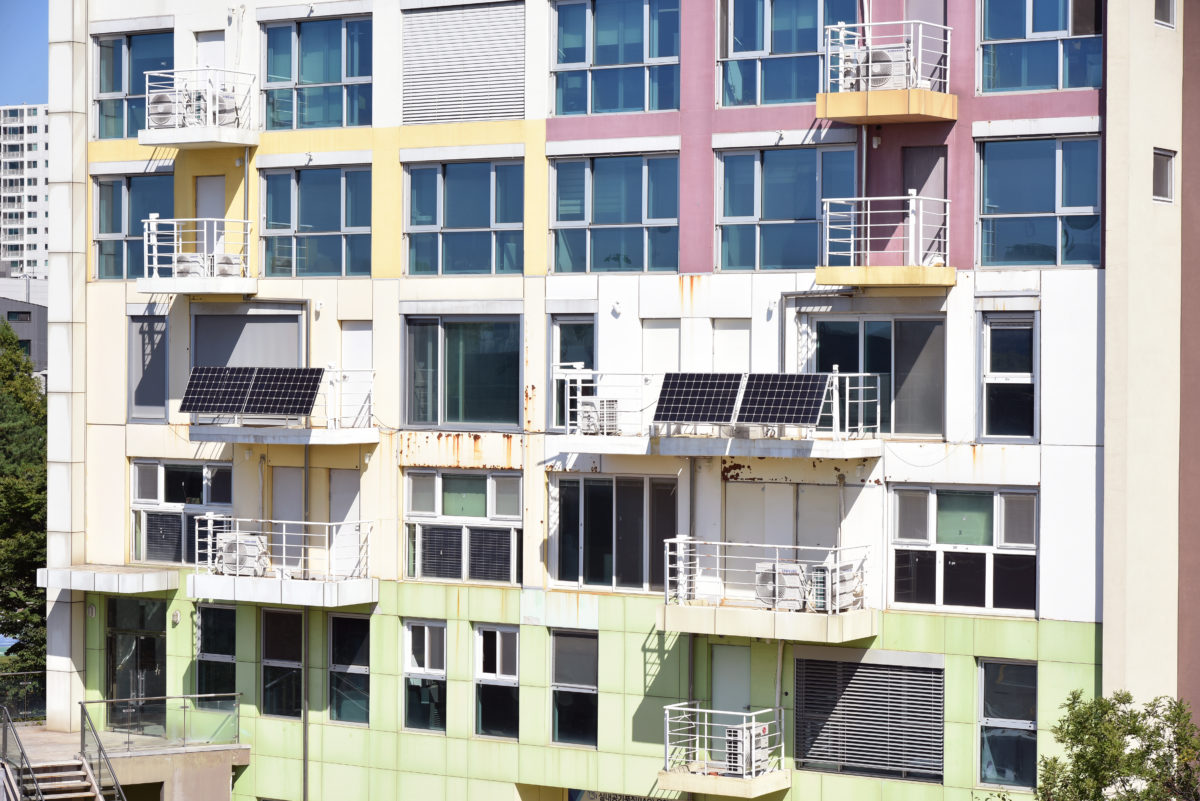Scientists at the Korea Institute of Civil Engineering and Building Technology have analyzed different operational modes to combine residential batteries with balcony PV modules in apartment buildings in South Korea.
In the proposed configuration, the battery is included in the hybrid system, but only to discharge power to the home appliance connected to the load line. The load is supplied by the balcony PV modules or the battery power, with surplus power being stored in the storage system when needed.
“The battery is charged with grid power when the battery is in system check or the (state-of-charge) level of the battery is at an emergency level,” the research group said.
The researchers simulated the hybrid system in a demonstration house in the Korean city of Goyang, with a 2.016 kWh prototype LiFePO4 battery with an efficiency of 93%. The system included a south-oriented 1.2 kW balcony PV system, built with four 300 W modules connected in series, with an efficiency of 18%. The tilt angle was 70 degrees, paired with a 260 W electric fan representing the connection load.
The researchers calculated the storage capacity of the battery by considering the PV system's capacity and the total power consumption of the household. The academics said the basic settings for battery energy storage system operation were set to battery bulk charge voltage of 58.4 V, with a battery discharge cut-off voltage of 41 V and a battery recharge voltage of 44 V.
“This system can be used anywhere, not just in South Korea, because of its small capacity,” researcher Ji-Young Eum told pv magazine.
The researchers evaluated the performance of the system under four operational modes. They looked at a configuration in which the PV system preferentially supplies the load and only charges the battery with PV power, as well as a system that supplies PV power to the load first and charges the battery with PV and grid power. In addition, they considered a design in which the battery is preferentially charged with PV power and only the PV power is supplied, alongside a system that preferentially charges the battery with PV power and then with PV and grid power.
“The experiment lasted about three months from Aug. 21, 2019, to Nov. 8, 2019,” the scientists said. “In order to check the charging and discharging results, the experiment was conducted on all days except rainy days and days that the apparatus were checked.”
Under the first mode, approximately 92% of the battery capacity was discharged and about 91% of the load was supplied to the battery, they found. They also observed that the battery voltage reached the full discharge voltage range of 33 V and, as a result, the battery was not used, as the battery voltage could not be maintained until the next PV charge.
Under the second mode, in which PV electricity was injected into the load with priority, it was almost impossible to charge the battery if there is no remaining PV power after the load is supplied, they said. They claimed that this makes it necessary to prevent the battery discharge by reducing its idle time and the use of grid electricity.
The third operational mode ensured that the battery was completely discharged and the battery voltage was not maintained until the charge of PV power the next day, when the PV electricity was then conveyed to the load and the grid. Under the fourth configuration, the battery had a good chance to end up being not fully discharged due to the charging of the grid power. And when the battery voltage reached the full discharge protection voltage, the battery was charged with grid power.
“The operation modes of the residential battery energy storage system … with the balcony PV were confirmed in individual households of apartment houses through experiments for each operation mode of the residential (battery energy storage system),” the researchers said. “The results suggest that mode four is the most appropriate among the four operation modes of (battery energy storage system). Nevertheless, some functions are still required to apply the scheme to individual households of apartments.”
The researchers described their work in “Operation Modes of Residential BESS with Balcony-PV for Apartment Houses in Korea,” which was recently published in Sustainability.
This content is protected by copyright and may not be reused. If you want to cooperate with us and would like to reuse some of our content, please contact: editors@pv-magazine.com.




The explanation about the four operation modes was just too muddled and confusing ..
Next time, use an excel like table to help you indicate all the different aspects, such as source of battery charging, its priorities, etc. A reporter should know that its first obligation is to be clearly understood ..